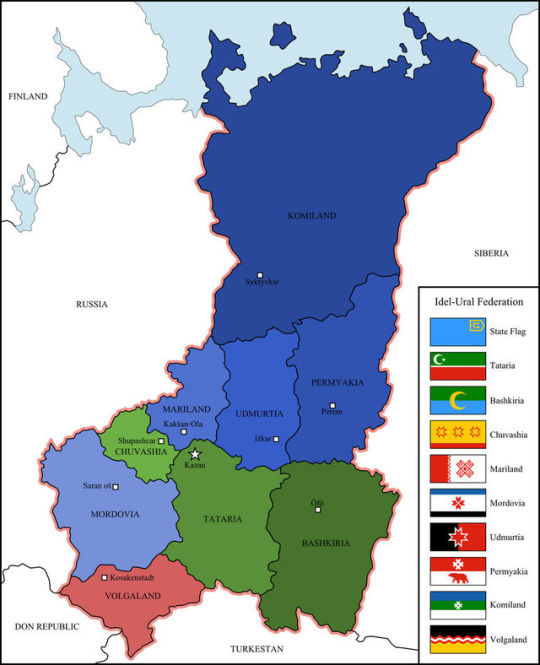#idel-ural
Text
youtube
"The Tale of the Mari Land" (1966)
4 notes
·
View notes
Text
People don't know this but there are six indigenous republics in the middle of Russia, whose autonomy has been progressively stolen by the Moscow government for decades despite treaties signed guaranteeing their rights. Yes, old-fashioned colonialism is still ongoing today, it's just more difficult to see when there's no ocean inbetween.
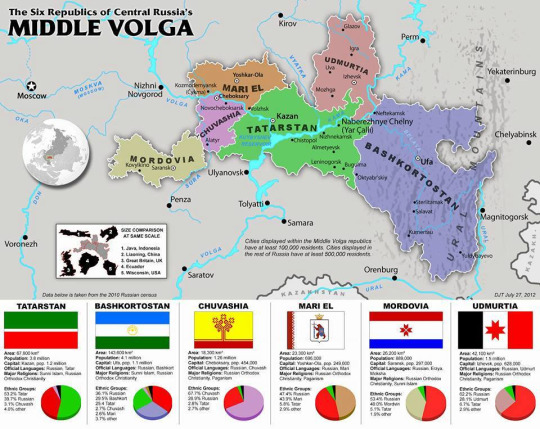
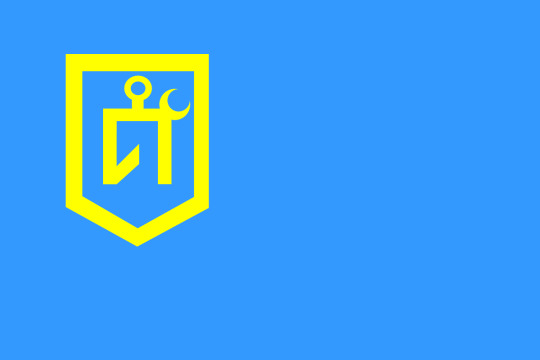
#i know that there are many other like these across the world#and that my own country too engages in neocolonialism#i just want to talk about a little-known but potentially powerful indigenous movement#idel-ural#free idel-ural
2 notes
·
View notes
Text
You Don't Speak for Us
You Don’t Speak for Us
A Statement by the Free Nations League
Regarding the Convocation of a Congress of People’s Deputies of the Russian Federation in Poland
From open sources, we have learned about an undertaking to convene a Congress of People’s Deputies in the town of Jabłonna, Poland (November 4–7, 2022). The delegates to the Congress are parliamentary deputies of different years and different levels who were…

View On WordPress
#Bashkirs#Buryats#Congress of People&039;s Deputies of the Russian Federation#Cossacks#Erzya people#ethnic minorities in Russia#Free Idel-Ural Movement#Free Nations League#Kalmyks#Radjana Dugar-DePonte#Rafish Kashapov#Ruslan Gabbasov#Russian imperialism#Russian opposition#separatism#Tatars
4 notes
·
View notes
Text
Pan-Turkism has been characterized by pseudoscientific theories known as Pseudo-Turkology.[64][65] Though dismissed in serious scholarship, scholars promoting such theories, often known as Pseudo-Turkologists,[64] have in recent times emerged among every Turkic nationality.[66][67] A leading light among them is Murad Adzhi, who insists that two hundred thousand years ago, "an advanced people of Turkic blood" were living in the Altai Mountains. These tall and blonde Turks are supposed to have founded the world's first state, Idel-Ural, 35,000 years ago, and to have migrated as far as the Americas.[66]
According to theories like the Turkish History Thesis, promoted by pseudo-scholars, the Turkic peoples are supposed to have migrated from Central Asia to the Middle East in the Neolithic. The Hittites, Sumerians, Babylonians, and ancient Egyptians are here classified as being of Turkic origin.[65][66][67][68] The Kurgan cultures of the early Bronze Age up to more recent times are also typically ascribed to Turkic peoples by pan-Turkic pseudoscholars, such as Ismail Miziev.[69] Non-Turkic peoples typically classified as Turkic, Turkish, Proto-Turkish or Turanian include Huns, Scythians, Sakas, Cimmerians, Medes, Parthians, Pannonian Avars, Caucasian Albanians, and various ethnic minorities in Turkic countries, such as Kurds.[69][70][71][67][68] Adzhi also considers Alans, Goths, Burgundians, Saxons, Alemanni, Angles, Lombards, and many Russians as Turks.[66] Only a few prominent peoples in history, such as Jews, Chinese people, Armenians, Greeks, Persians, and Scandinavians are considered non-Turkic by Adzhi.[66]
Philologist Mirfatyh Zakiev, former Chairman of the Supreme Soviet of the Tatar ASSR, has published hundreds of "scientific" works on the subject, suggesting Turkic origins of the Sumerian, Greek, Icelandic, Etruscan and Minoan languages. Zakiev contends that "proto-Turkish is the starting point of the Indo-European languages".[66] Not only peoples and cultures, but also prominent individuals, such as Saint George, Peter the Great, Mikhail Kutuzov and Fyodor Dostoevsky, are proclaimed to have been "of Turkic origin".[66] As such the Turkic peoples are supposed to have once been the "benevolent conquerors" of the peoples of most of Eurasia, who thus owe them "a huge cultural debt".[66][72]
The pseudoscientific Sun Language Theory states that all human languages are descendants of a proto-Turkic language and was developed by the Turkish president Mustafa Kemal Atatürk during the 1930s.[73] Kairat Zakiryanov considers the Japanese and Kazakhgene pools to be identical.[74] Several Turkish academics (Şevket Koçsoy, Özkan İzgi, Emel Esin) claim that Zhou dynasty were of Turkic origins.[75][76][77][78]
what is going on with the turkish
341 notes
·
View notes
Text
As a fact of history and problem of contemporary geopolitics, Russia’s nature as an imperial power is incontrovertible. After World War I, the Russian Empire avoided the permanent dismemberment that befell other multi-ethnic land empires, such as the Ottoman Empire and Austria-Hungary. The Soviet Union not only reconquered most of the non-Russian lands that had declared independence from Moscow in the wake of the 1917 Bolshevik Revolution (including Ukraine, Belarus, Georgia, Armenia, and Azerbaijan)—but even expanded the empire in the course of World War II, annexing Moldova, the western part of Ukraine, and other lands. Nor did the Soviet Union participate in the decolonization era. Even as the French and British empires were being dissolved, the Soviet Union was expanding its colonial reach, tightening its grip deep into Eastern and Central Europe with bloody crackdowns and military actions.
[...]
During the Cold War, Western universities, research institutions, and policy think tanks opened numerous centers and programs for Soviet, Russian, and Eurasian studies in a bid to better understand the Soviet Union and its heritage. However, these efforts had a strategic flaw: Born in an era when Moscow’s control reached far beyond today’s Russian borders, these programs inevitably framed the region through a Moscow-centric lens. Today, even as they dropped “Soviet” from their name, most of these programs have inherited this old Moscow-centric framing, effectively conflating Russia with the Soviet Union and downplaying the rich histories, varied cultures, and unique national identities of Eastern Europe, the Baltic States, the Caucasus, and Central Asia—not to mention the many conquered and colonized non-Russian peoples inhabiting wide swathes of the Russian Federation.
[...]
In many cases, Western academic programs require students to study the Russian language—often including courses in Moscow or Saint Petersburg—before they have the option of studying any of the region’s other languages, if they are so inclined and if those languages are even offered. A similar problem affects cultural studies, including literature and art, where the many ways Russian works—including the classics read by countless high school and university students—transport Moscow’s imperial ideology are rarely addressed. This only perpetuates the habit of looking at the former Soviet-controlled and Russian-occupied space through the prism of the world’s last unreconstructed imperial culture. Unwittingly, today’s Russia studies in the West still replicate the worldview of an oppressor state that has never examined its history and is nowhere near having a debate about its imperial nature at all—not even among the Russian intellectuals or so-called liberals with whom Western students, academics, and analysts generally interact and cooperate.
Finally, Western academia also presents Russia itself as a monolith, with little or no attention paid to the country’s Indigenous peoples. By now, many who study Russian history are at least vaguely familiar with the Stalin-era genocide of the Crimean Tatars and their replacement on the peninsula by Russian settlers. But why not shed more light on the Russian conquest and subjugation of Siberia, one of the most gruesome episodes of European colonialism? Or Russia’s 19th-century mass murder of the Circassians, Europe’s first modern-era genocide? What have we learned about the short-lived Idel-Ural state, a confederation of six autonomous Finno-Ugric and Turkic republics crushed by the Bolsheviks in 1918? Why not highlight Tatarstan, which proclaimed its independence from Russia in 1990? Nascent efforts to give Russia’s Indigenous peoples a voice have gotten underway, including the Free Peoples of Russia Forum that last convened in Sweden in December 2022—but they have hardly registered in Western academia. Not only are Western scholars’ interests and relationships Russia-centric; within Russia, those relationships and contacts are Moscow-centric. It’s as if Russia’s highly diverse regions didn’t exist.
#russia#russian culture#russian inmperialism#slavic studies#slavic tradition#slavic culture#decolonisation#postcolonialism#imperialism#rashism#rushism#academia
196 notes
·
View notes
Text
League of Free Nations: Indigenous activists from Russia to fight for independence from Moscow

Kalmyks in Elista, Republic of Kalmykia. Source: Wikipedia
2022/05/24 - 00:00 • INTERNATIONAL, RUSSIA, RUSSIAN AGGRESSION
Article by: Christine Chraibi
Indigenous activists from Russia, representing six national movements, have announced the creation of the League of Free Nations– a political platform for the decolonization of indigenous peoples in the Russian Federation and the acquisition of each nation’s sovereignty.
With the outbreak of the Russo-Ukrainian war on 24 February, 2022, many Russian citizens of indigenous nations have been wittingly or unwittingly drawn into the ranks of the Russian army. However, most are there because they are trying to escape the horrible poverty they experience at home and see the military as the best or in many cases only way to improve their sorry lives.
Indigenous peoples have been under the Russian yoke for centuries
Back in April 2021, Sires Bolaen (Syres Boliayen), Inyazor (Chief Elder) of the Erzya people, addressed the 20thsession of the UN Permanent Forum on Indigenous Issues, drawing attention to the Kremlin’s policy of purposeful neglect and discrimination of indigenous people.
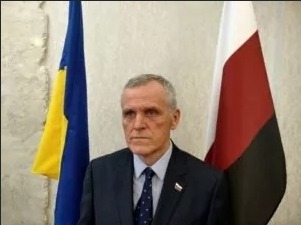
Sires Bolaen (Syres Boliayen), Inyazor (Chief Elder) of the Erzya people. Photo: open source
“Within the past 30 years, the Ezrya have been turned from a nation of a few million people into a small ethnic group on the brink of complete extinction.
Our neighbours in the Idel-Ural region – Mokshans, Udmurts, Maris, Chuvashs, Bashkirs and even Tatarsalso find themselves in a very similar position. Native peoples in Russia are forbidden to have their own political parties, or even to study their mother tongue in secondary schools. Only dancing in national costumes is tolerated. Those who stand up for their rights are persecuted as extremists and become victims of punitive psychiatry.”
The leader of the Erzya national movement is known not only for his anti-imperialist stance, but also for leading a group of Erzya volunteers fighting with the Ukrainian army. He is the co-founder of the Free Idel-Ural movement,which advocates the withdrawal of six Volga republics (Bashkortostan, Tatarstan, Chuvashia, Mordovia, Mary El and Udmurtia) from the Russian Federation and the creation of the Idel-Ural confederation.
In May 2022, Sires Bolaen once again addressed the UN Permanent Forum on Indigenous People during its 21stsession. He publicly condemned and blamed Moscow for turning federal republics and indigenous communities in Russia into socially backward and under-developed regions where local young people seek to escape poverty by joining the Russian Armed Forces.
North Ossetia, Buryatia, Tuva, Dagestan, Ingushetia, Chukotka and Idel-Ural are the regions with the highest number of dead soldiers per thousand population, he says.
Indigenous peoples gather in the League of Free Nations
In order to draw attention to the dire situation facing the indigenous people of Russia,Bashkir, Buryat, Ingush, Kalmyk, Erzya and Adyghe activistsdecided to set up a new organization – the League of Free Nations – and proceeded to issue a public announcement.
“These past few weeks, various media have been writing and talking more about the future of the Russian Federation after the Russian-Ukrainian war.
First of all, these discussions do not concern the organization of the federal subjects of the Russian Federation, but look more towards the paradigm ‘the future of the federal center is the future of Russia’.”reads the statement.
Vladimir Dovdanov, member of the Oirat-Kalmyk People’s Congressunderlines that his people have been experiencing colossal demographic catastrophes for centuries.

Vladimir Dovdanov, member of the Oirat-Kalmyk People’s Congress. Photo: Idel Realii (RFE/RL)
“…This is due to the fact that we’ve always been treated as a colony ruled by a tsar. Later [during the Soviet period-Ed], the different general secretaries used the Kalmyksas disposable objects. Today, as a result of Russia’s military aggression against Ukraine, major global political changes are taking place, and this gives us the opportunity to become a subject state, and no longer be treated as an object. I see that many other peoples in the Russian Federation have the same desire.”
In their manifesto, the indigenous leaders proclaim the principle of “presumption of subjectivity/agency”, according to which the regions do not need to appeal to anyone to grant them sovereignty in the event of the collapse of the current political regime in the Russian Federation,.
All regions, by definition, can achieve and declare full sovereignty and full independence from Moscow. Then, acting as free territories, they can decide their own future: whether they want to remain independent, unite with other regions/republics, or create a confederation of states.
Sires Bolaen, Inyazor (Chief Elder) of the Erzya peopleassures that the League of Free Nations is open to new members and invites all those who share anti-imperialist views and recognize the right of peoples to self-determination to join the organization.
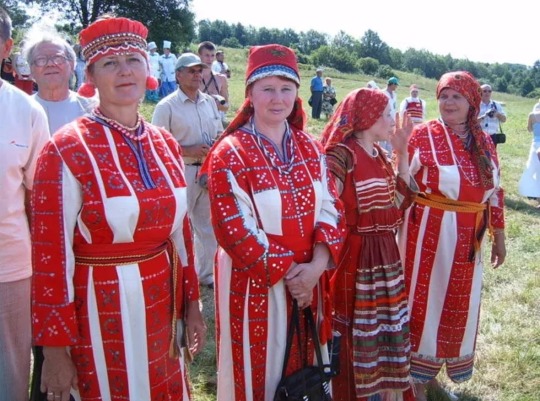
Erzya women from Penza Oblast dressed in traditional clothes. Source: Wikipedia
Activists of the Buryat national movement Dorjo Dugarov and Rajana Dugar-De Ponte, who co-founded the platform, believe that uniting different national movements around the struggle for freedom and political subjectivity will have a cumulative effect – in particular, open new opportunities for the members to convey their ideas on different international platforms.

Activist Ruslan Gabbasov from Russia’s Republic of Bashkortostan. Photo: Idel Realii
Activist Ruslan Gabbasov from Russia’s Republic of Bashkortostan, who fled Russia in December 2021 fearing for his safety and obtained political asylum in Lithuania, is a representative of the Bashkir national movement.
“I believe that all constituent subjects, as well as all indigenous peoples of the Russian Federation have the right to participate in the discussion on the future of Russian territories and to exercise their right to self-determination,”said Gabbasov .
The initiators of the League of Free Nations are as follows:
Vladimir Dovdanov, Batyr Bormongaev, Erenzen Doliaev(Kalmyks, Republic of Ralmykia)
Ruslan Gabbasov(Bashkir, Republic of Bashkortostan)
Sires Bolen and Vitaliy Romashkin(Erzyas, one of the peoples of the Republic of Mordovia)
Dorjo Dugarov, Rajana Dugar-De Ponte(Buryats, Republic of Buryatia)
Today, the members of the League of Free Nations call for the establishment of direct contacts with European, Turkish and Kazakh public organizations and political parties.

Administrative mao of the Russian Federation. Photo: World Atlas
Editor’s Note
Background
According to its constitution, the Russian Federation is divided into 85 federal subjects, 22 of which are republics. Republics are administrative divisions originally created as nation states to represent areas of non-Russian ethnicity. The indigenous ethnic group that gives its name to the republic is referred to as the titular nationality. However, due to decades of Russian migration, each nationality is not necessarily a majority of a republic’s population.
During his long years in power, Vladimir Putin has launched several centralization reforms which steadily eradicated all autonomy the republics had, with the exception of Chechnya. All bilateral agreements were abolished and in practice all power rests with the central federal government.
In fact, some experts believe that Russia has ceased to be a federation.
#indigenous#culture#indigenous russia#indigenous russian#russia#important#fypシ#colonization#fypage#landback#siberian indigenous#indigenous siberian#siberian#siberia#indigenous rights#indigenous people#freenations#League of Free Nations#russian imperialism
71 notes
·
View notes
Text
It seem like someone pirated mezzo's recording of "Jalil" and downloaded it on youtube. Good for them tbh and good for us.
"Jalil" is a Tatar opera written by Nazib Zhiganov in 1957. It's about XX century Tatar poet Musa Jalil, who was executed by Nazis in 1944. He participated in WWII and was captured Nazis in 1942, he agreed to join Idel-Ural legion and became a part of inner resistance movement in Wehrmacht. Their group agitated Idel-Ural soldiers to sabotage, desert and switch sides. They were so successful that one battalion switched sided in the moment they came closer to Belarusian partisans, and others became absolutely unsuitable for combat because of mass deserting and sabotaging. Unfortunately their resistance group was uncovered by Nazis, and all participants were executed. Musa Jalil continued to write his poems in prison, he was able to hand over his notebooks to his cellmates, who survived and brought Jalil's poems to USSR later.
This part of Musa Jalil's life and his death are the plot of the opera. You can read libretto here (in Russian). The recording has French subtitles. The opera itself is written mostly in Tatar with some recitatives and arias in Russian, and it's fascinating how they switch from Tatar to Russian when there are dialogues with non-Tatar characters and there are accidental Russian words in Tatar dialogues and Tatar words in Russian. They also have Germans singing in German and there are two songs in other languages (Kazakh and French I assume but I am not sure).
youtube
Jalil was branded as a traitor by Soviets. His family was under suspicion. Only in early 1950s, after Stalin's death, I presume, Tatar writers and Konstantin Simonov was able to make Soviets drop charges. In 1953 Jalil poems were published in Literaturnaya Gazeta, and there was an article in Pravda about him participating in resistance.
4 notes
·
View notes
Note
yeah I figured from your posts, I love and admire the Tatar culture 🩵 annnd other Russian ethnic minorities are also fascinating I love to read about them, like the ones in the far east :)
Бик зур рәхмәт! Oh you maybe talking about Sakha (Yakut) people? Love them too. But my favorite is Idel-Ural region (Tatar, Bashkurt, Mari, Chuvash, Mordva, Udmurt).
My favorite cultural thing is the Mari ornament. It is even on the flag of the republic.
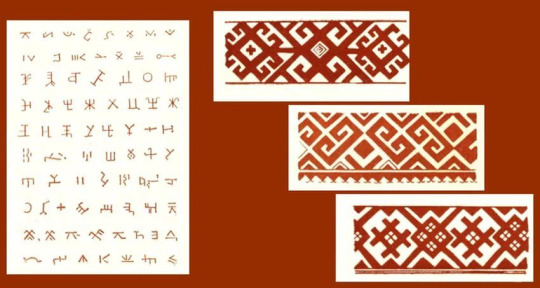


0 notes
Text
Hey people! Im planning starting a blog about Tatar culture. Personally I will post more about Volga/Kazan Tatars which I belong to, but if there is someome from Crimean, Siberia etc Tatars, or just anyone who wants to take part, I'll be very grateful!
18 notes
·
View notes
Text
Putin’s tale about unity of Russians and Ukrainians prompts Kazan scholar to speak about real unity of Turkic peoples
Putin’s tale about unity of Russians and Ukrainians prompts Kazan scholar to speak about real unity of Turkic peoples
“Historically,” Khakimov says, “the Turkic peoples formed on the territory of the Turkic khanate … extending from the Caspian to the Danube.” They were “close in culture and language,” and even borrowings from Arabic and Persian and later Russian did not change that fundamentally.
Tatars had a written language centuries ago. It served as the lingua franca of the Turkic peoples and as the…
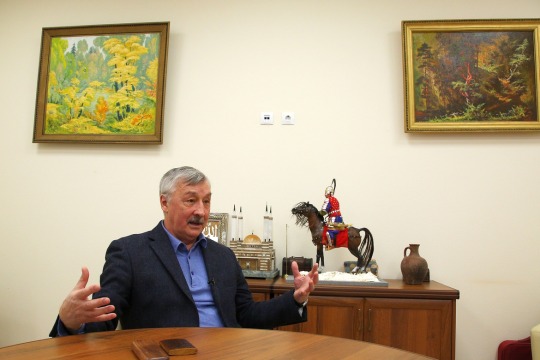
View On WordPress
#Bashkirs#Bashkortostan#distortion of history#History#Idel Ural#indigenous peoples in Russia#Kazan Tatars#Muscovy#Muscovy history#Russia#Russian history#Russian imperialism#Tatarstan
1 note
·
View note
Photo

Claiming a vast swath of land and uniting Tatars, Bashkirs and the Chuvash with Volga Germans, the Idel-Ural State was short lived, being conquered by Soviet Russia in 1918.
4 notes
·
View notes
Text
fuck it it's emeze-emeze time
youtube
3 notes
·
View notes
Text
since i haven't seen this around here, the following is a thread from twitter about russian colonialism, i only organised it chronologically.
"moscow is awfully uncreative. in the last one hundred years #RussianColonialism has been using the same invasion and occupation tactic over and over and over again. thread on twitter."
1917-32. ukraine tries to to leave #RussianColonialism. moscow invades to ‘stop violence’, spends years on a mass murder spree across the country, stokes unrest and eventually occupies it. kremlin uses the holodomor genocide and mass terror to crush the resistance
1917-20. azerbaijan tries to leave #RussianColonialism. moscow manufactures fakes about mass murders and invades ‘to stop violence’. tens of thousands slaughtered (source)
1917-20. armenia tries to leave #RussianColonialism. moscow manufactures fakes about mass murders and invades ‘to stop violence’
1917-24. georgia tries to leave #RussianColonialism. moscow stages ethnic violence and invades to ‘stop it’. over 15,000 executed and 20,000 deported in ethnic cleansing of georgians (source)
1917-22. ukrainians of the far east try to leave #RussianColonialism. they form the zeleny klyn state as part of newly-independent ukrainian people's republic, a democratic council, an army. a proto-state collapses with the russian occupation of ukraine (source)
1917-20. kuban cossacks try to leave #RussianColonialism. they form a democratic parliament, a republic, join newly-independent ukrainian people's republic in a federation. after the invasion of ukraine, they get encircled and crushed by moscow (source)
1917-21. bashkortostan tries to leave #RussianColonialism and becomes the world's first muslim democracy. moscow stokes internal divisions, lures into a military union and then absorbs the republic, murders over 10,000 in following anti-colonial uprisings (source)
1917-18. indigenous nation of crimean tatars tries to leave #RussianColonialism, founds the second-ever muslim democracy. moscow overthrows the government, executes 33-yo president numan çelebicihan, throws his body into the sea. ethnic cleansing follows (source)
1917-20. estonia tries to leave #RussianColonialism. moscow invades using token estonians & disinfo claiming 'liberation' of the country. with solidarity of uk & finland estonians managed to defend newly-born post-colonial democracy (source)
1918-45. north caucasus tries to leave #RussianColonialism. moscow stages ethnic violence and invades to ‘stop it’. mass ethnic cleansing and deportations in following two decades kill hundreds of thousands (source)
1918. idel-ural tries to leave #RussianColonialism. a tatar proto-republic had one of the first democratic muslim parliaments and constitutions in the world. moscow stokes internal ethnic divisions, kidnaps MPs, invades and disbands the parliament (source)
1918. latvia tries to leave #RussianColonialism. moscow manufactures a civil war, but fails to take over the country and latvians manage to defend newly-born post-colonial democracy (source)
1918. lithuania tries to leave #RussianColonialism. moscow breaks the word on international post-ww1 treaty that guaranteed lithuanian independence, creates a puppet statelet litbel to legitimize the invasion, orchestrates a coup, but lithuanians push back (source)
1918. belarus tries to leave #RussianColonialism. moscow creates a puppet statelet litbel to sabotage the independence movement. small belarusian army resists enormous kremlin forces for over a month on a heroic suicide mission but loses (source)
1919-22. karelia tries to leave #RussianColonialism. moscow crushes anti-colonial uprisings, bans democratically-elected assembly, creates a puppet govt. hundreds slaughtered, approx 30,000 became refugees, local language/culture banned in 1930s (source)
1920. central asia tries to leave #RussianColonialism. moscow invades to protect from ‘ethic violence’. bukhara, one of the oldest cities in the world, ends up in ruins. 150,000 slaughtered across the region in pogroms and ethnic cleansing (source)
1924. tungus republic of indigenous arctic nations tries to leave #RussianColonialism after centuries of genocides, exploitation, cultural erasure. moscow lured the republic in ceasefire with fake autonomy promises, then mass slaughtered the leadership (source)
1927. sick of exploitation of indigenous lands, yakutia tries to leave #RussianColonialism, form a democratic confederation. moscow lures the leaders into a false autonomy and amnesty deal, then breaks the word, executes most of the uprising's participants (source)
1929-30. north afghanistan becomes a base for anti-colonial fighters from central asia. plus, unpopular afghan king gets ousted, asks #RussianColonialism to invade. kremlin sends troops dressed in afghan uniforms. they slaughter hundreds, but return home (source)
1929-44. tannu-tuva tries to leave #RussianColonialism. moscow stages a coup, installs a puppet regime, starts cultural erasure, sends ethnically russian settler colonialists, forces tuva to grant them citizenship and eventually annexes the country (source)
1930. kazakhstan tries to leave #RussianColonialism amid moscow's wild pillage of farming lands and local resources. over 372 uprisings and rebellions pop up, some are explicitly anti-colonial. kremlin suppresses most of them, thousands killed (source)
1930-43. under the pressure of settler colonialism, indigenous nation of crimean tatars tries to leave #RussianColonialism via several uprisings. moscow lies it wants to protect itself and targets the nation with genocide & deportation. every second dies (source)
1932. indigenous nation of dolgans tries to leave #RussianColonialism after getting sick of economic exploitation and cultural erasure. moscow drowns the taymyr uprising in blood and mass repressions (source)
1933. indigenous siberian nation of khanty tries to leave #RussianColonialism after centuries of genocides, exploitation, cultural erasure and mass abductions. anti-colonial uprising was drowned in mass murder (source)
1934-43. indigenous nation of nenets tries to leave #RussianColonialism after centuries of genocides, exploitation, cultural erasure. the mandalada uprising was drowned in another genocide (source)
1939. moscow fabricates 'ethnic conflicts' and invades poland to protect 'minorities' — as a facade for a secret #RussianColonialism deal with hitler to divide europe. around 200,000 slaughtered in german-russian invasion (source)
1939. moscow lies it wants to protect itself from security threats inside finland & invades it as part of a secret #RussianColonialism deal with hitler to carve up europe. amid heavy losses kremlin settled for 11% of finland. over 400,000 slaughtered (source)
1940. moscow makes a #RussianColonialism deal with hitler, lies it wants ‘to protect itself’, bullies estonia, latvia, lithuania into accepting russian military bases, uses them to invade. Over 179,000 deported, tens of thousands die in ethnic cleansing (source)
1940. moscow wants to punish finland for leaving #RussianColonialism. it creates a puppet statelet on finish lands occupied earlier, promises to protect it from ‘genocide’, uses as a front for invasion of finland (source)
1940. moscow makes a #RussianColonialism deal with hitler, lies it wants ‘to protect itself’, invades romania and annexes 15% of romanian territory (source)
1953. east germany tries to leave #RussianColonialism, millions show up for pro-democracy rallies. moscow uses a formal help request from a puppet regime to send tanks, kill hundreds and crush the uprising (source)
1956. hungary tries to leave #RussianColonialism, students launch a popular pro-democracy uprising. moscow uses a facade collective security pact to invade. thousands slaughtered, uprising crushed (source)
1968. czechs and slovaks try to leave #RussianColonialism. moscow uses a facade collective security pact to invade. 137 slaughtered, the uprising is crushed (source)
1986. kazakhstan tries to leave #RussianColonialism, the jeltoqsan pro-democracy uprising becomes the country's own tiananmen moment. moscow dispatches kill squats: hundreds protesters executed, but they inspire anti-colonial fighters across the empire (source)
1989. georgia wants to leave #RussianColonialism. moscow sends troops to mass murder a peaceful pro-independence uprising in tbilisi. 19 killed. instead of demoralizing, it turbo-charges the independence push (source)
1990. azerbaijan wants to leave #RussianColonialism. moscow fuels ethnic hatred, uses it as an excuse to send tanks & slaughter independence supporters. 170 die in the january massacre. instead of demoralizing, it turbo-charges the independence push (source)
1990-91. lithuania leaves #RussianColonialism. moscow puts economic blocade, uses disinfo to further ethnic strife, sends tanks to roll over peaceful protesters. 15 killed, but lithuania withstands. demoralized russians go home (source)
1990-91. latvia leaves #RussianColonialism. moscow orchestrates bombings, stokes ethnic hatred, fuels fear and hysteria via disinfo. citizens build barricades, meet kremlin kill squads mostly unarmed. 6 killed. demoralized russians go home (source)
1991. estonia leaves #RussianColonialism. moscow sends tanks to drag it back. estonians mount barricades, peacefully confront invaders. demoralized russians go home (source)
1992. moldova leaves #RussianColonialism. moscow punishes it by fueling ethnic strife, uses it as a pretext for annexing 10% of the country, and creating a russian-control statelet of transnistria (source)
1992. georgia leaves #RussianColonialism. moscow punishes it by fueling ethnic strife & a civil war. kremlin claims 'neutrality' but keeps sending weapons, money to support breakaway regions. georgia ends up broken, with pro-russian kleptocratic regime (source)
when foreigners casually drop ‘bombing of kyiv’ these pics always come to mind. this is what #RussianColonialism did to chechnya and grozny when they tried to leave the empire in 2000. a war crime of horrific scale, but the rest of the world was like ‘meh’, so moscow continued (source)
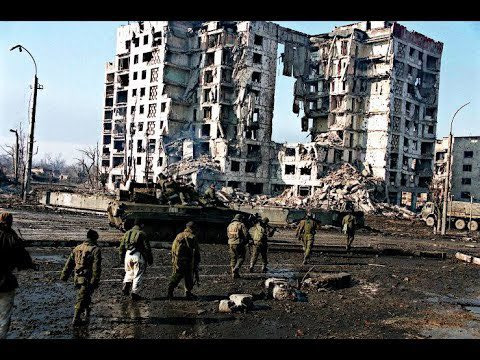


2008. georgia kicks out a pro-#RussianColonialism kleptocratic regime and moves towards rejoining with europe. kremlin decides to punish it. moscow uses disinfo to fabricate claims about 'imminent genocide', invades and occupies 20% of the territory (source)
2014. ukraine kicks out a pro-#RussianColonialism kleptocratic regime. kremlin decides to punish it, creates false disinfo narrative about ethnic strife, claims 'neutrality' but sends troops to create breakaway stateless and annex crimea (source)
2015. syria is about to kick out a tyrant and get rid of a key #RussianColonialism military base. moscow sends troops to carpet bomb, gas and mass murder civilians - all to stop 'imminent genocide'. 600,000 killed, 7 million displaced (source)
2022. russia wants to punish ukraine for leaving #RussianColonialism, creates fake ‘genocide’ narratives, uses puppet statelets as a front for invasion. invaders engage in mass war crimes, but blitzkrieg fails and they face unprecedented resistance from the population. TBC
#russian colonialism#russian imperialism#russia#soviet union#ukraine#war in ukraine#estonia#latvia#lithuania#poland#georgia#finland#moldova#tagging only some countries bc there are so many of them
602 notes
·
View notes
Photo


Food: Baursaki - Kazakhstan
More commonly known as Boortsog, the Baursaki is a type of fried dough food found in the cuisines of Central Asia, Idel-Ural, Mongolia and the Middle East. It is shaped into either triangles or sometimes spheres. The dough consists of flour, yeast, milk, eggs, margarine, salt, sugar, and fat.Tajik boortsog are often decorated with a criss-cross pattern by pressing the bottom of a small strainer on the dough before it is fried.
Boortsog is often eaten as a dessert, they are sometimes compared to doughnuts. Mongolians and Turkic peoples sometimes dip boortsog in tea. In Central Asia, baursaki are often eaten alongside who is called chorba.

The preparation for the dough for Baursaki ranges in ingredients from a simple dough, to a sweeter, crispier dough. For example, a typical recipe calls for one part butter, 7 parts salt water, and 6 parts milk, along with yeast and flour, while more complex recipes add eggs and sugar. Also the dough could be made with Kaymak.
Boortsog are made by cutting the flattened dough into pieces. While not usually done in Central Asia, these pieces may be bent and knotted into various shapes before being deep fried. This is especially common among Mongolians. The dough is deep-fried golden brown. Mutton fat is traditionally used by Mongolians to give the boortsog extra flavor, but vegetable oil may be substituted.
11 notes
·
View notes
Photo
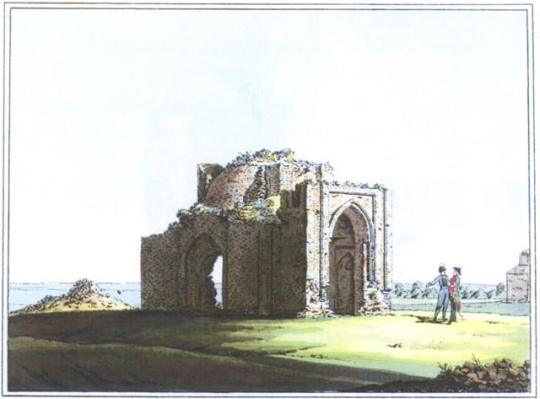

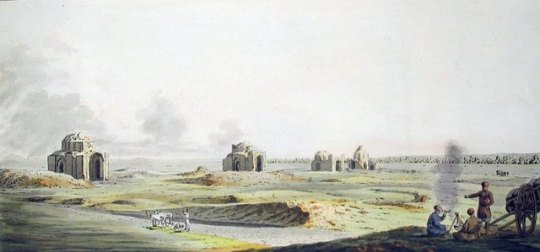
Развалины золотоордынского города Маджар. 1780
Художник П.С.Паллас
Арабский путешественник Ибн Баттута, посетивший Маджар в 1333 году, оставил в путевом дневнике, известном как «Подарок н��блюдателям по части диковин стран и чудес путешествий», запись:
«Город Маджар большой, один из лучших тюркских городов, на большой реке, с садами и обильными плодами. Мы остановились там в ските благочестивого, религиозного, престарелого шейха Мухаммеда Эльбатаиха, родом из Батиаха Иракского».
В своих заметках Ибн Баттута еще раз упоминает город Маджар, ставя его в один ряд с крупнейшими золотоордынскими городами. Характеризуя Узбек-хана, он говорит: «Владения его обширны и города велики. В числе их: Кафа, Крым, Маджар, Азов, Судак, Хорезм и столица его Сарай».
В «Дербенд-наме» («Истории Дербента»), в историческом сочинении XVII века, Большие и Малые Маджары упоминаются с VIII века как города Хазарского каганата. В период расцвета (XIII—XIV вв) город был крупным ремесленным и торговым центром в составе Золотой Орды, в 1310—1311 имел особый статус, чеканил собственную монету. Население имело смешанный этнический состав: тюрки, русские, аланы, евреи и др.После распада Золотой Орды, с 1459 года город входил в состав Астраханского ханства.
Ruins of the Golden Horde city Majar. 1780
P.S Pallas
Majar or Macar was a medieval city of Golden Horde in 13th-14th centuries. It once played a major role in the trade between Idel-Ural, Caucasus and the Black Sea region.The ruins of buildings, public baths, water pipes and workshops, and other remains of the city are situated on the river Kuma near Budyonnovsk, Stavropol Krai, Russia.The town was visited by Ibn Battuta in around 1333 : "I then set out for the city of al-Māchar, a large town, one of the finest of the cities of the Turks, on a great river, and possessed of gardens and fruits in abundance."
2 notes
·
View notes
